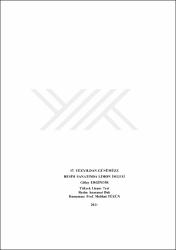| dc.contributor.advisor | Tüzün, Melihat | |
| dc.contributor.author | Ergindir, Gülay | |
| dc.date.accessioned | 2022-04-06T06:49:18Z | |
| dc.date.available | 2022-04-06T06:49:18Z | |
| dc.date.issued | 2021 | |
| dc.identifier.uri | https://tez.yok.gov.tr/UlusalTezMerkezi/TezGoster?key=RjZwH00oMG4iNa5SgvlggwHvmigYLUOE_71X2M-dZH43N1CLdXEWtb3EBhsgMnHX | |
| dc.identifier.uri | https://hdl.handle.net/20.500.11776/4039 | |
| dc.description.abstract | Natürmort türünde hemen hemen her resimde yer alan limon imgesi, kendisine yeni anlamlar yüklenen bir anlatım aracı olarak varlığını sürdürmektedir. 17. yüzyıldan günümüze kadar geçen süreçte ressamların resimlerinde limonu nasıl ve hangi amaçla resmettikleri çeşitlilik göstermiştir. Ressamlar kendilerine ait üsluplarıyla, limonu eserlerinde kullanmışlardır. 17. yüzyıldan önce limon objesine pek fazla rastlanılmasa da, 17. Yüzyıldan sonra natürmort türünde karşımıza sıklıkla çıkmaktadır. Günümüzde de limon objesi sanatçılara esin ve ışık kaynağı olmaktadır. Limonun dokusu, içerisindeki asimetrik dilimler, kabuğu ve rengi ile ressamların her zaman ilgisini çekmektedir ve çekmeye de devam etmektedir. 17. yüzyıldan günümüze imge olarak limonun yerini ve önemini ortaya konulmuş ve bu çerçevede yapılan kişisel limon imgelerinin yorumları paylaşılmıştır. Tez çalışmasında giriş bölümünün ardından alt bölümler olan, problem, varsayım cümlesi, tezin amacı, evren ve örneklem, yöntem ve teknik, verilerin toplanması oluşturmaktadır. Birinci bölümde natürmortun tanımı üzerinde durularak, natürmortun tarihini açıklanmıştır. Dönemin önemli sanatçıları hakkında bilgiler verilip, eserlerinden örnekler bulunmaktadır. Sanatçıları natürmort yapmaya teşvik eden nedenler üzerinde durulmuştur. Resim sanatı tarihinde natürmortlar seyirciye, dönemin ekonomik, sosyolojik, dini konularıyla o dönem hakkında bilgi verirler. İkinci bölümde 17. ve 18. yüzyıl resim sanatında limon imgesine ait bilgiler ve 17. 18. yüzyılda resim sanatında limon çalışan ressamlara ilişkin bilgiler ve eserleri bulunmaktadır. Üçüncü bölümde 19. ve 20. yüzyıl resim sanatında limon imgesine ait bilgiler ve 19. 20. yüzyılda resim sanatında limon çalışan ressamlara ilişkin bilgiler ve eserlerine yer verilmektedir. Türk resminde natürmort ve limon imgesi de dördüncü bölümde yer almaktadır. Bu bölümde hem Türk ressamların eserleri incelenmiş hem de sanatçılara ait kısa bilgiler bulunmaktadır. Dördüncü bölümde günümüz sanatında limon çalışan ressamlara ilişkin bilgiler ve eserlerine yer verilmektedir. Tezin son bölümünde çalışmaya ilişkin sonuç ve değerlendirmeler yer almaktadır. | en_US |
| dc.description.abstract | The lemon image, which takes place in almost every painting in the still life genre, continues to exist as a means of expression with new meanings attached to it. From the 17th century to the present, how and for what purpose the painters depicted lemons in their paintings varied. Painters have used lemon in their works with their own style. Although lemon objects in the still life type were not encountered very often before the 17th century, we encounter them frequently after the 17th century. Today, the lemon object is a source of inspiration and light for artists. The texture of the lemon, the asymmetrical slices inside, its peel and color have always attracted the attention of painters and continue to attract.To reveal the place and importance of lemon in the history of modern art from the 17th century to the present and to share the interpretations of personal lemon images made in this context. In the the thesis, after the introduction, the sub-sections, the problem, the hypothesis statement, the purpose of the thesis, the universe and the sample, the method and the technique, constitute the collection of data. In the first chapter, the definition of still life is emphasized and the history of still life is explained. Information about the important artists of the period is given and examples of their works are available. The reasons that encourage artists to make still lifes are emphasized. In the history of painting, still lifes inform the audience about the economic, sociological and religious issues of the period and that history. In the second part, information about the Lemon Image in the 17th and 18th Century Painting Art and the information and works of the Painters Working Lemon in the 17th-18th Century Painting Art are given. In the third chapter, information about the Lemon Image in the 19th and 20th Century Painting Art and the information about the Painters Working Lemon in the 19th 20th Century Painting Art and their works are given. Still Life and Lemon Image in Turkish Painting are also included in the fourth section. In this section, both the works of Turkish painters are examined and there is brief information about the artists. In the fourth chapter, information about the Painters Working Lemon in Contemporary Art and their works are given. In the last part of the thesis, there are results and evaluations related to the study. | en_US |
| dc.language.iso | tur | en_US |
| dc.publisher | Tekirdağ Namık Kemal Üniversitesi | en_US |
| dc.rights | info:eu-repo/semantics/openAccess | en_US |
| dc.subject | Güzel Sanatlar | en_US |
| dc.subject | Fine Arts | en_US |
| dc.subject | Natürmort | en_US |
| dc.subject | Limon | en_US |
| dc.subject | İmge | en_US |
| dc.subject | Işık-gölge | en_US |
| dc.subject | Still Life | en_US |
| dc.subject | Lemon | en_US |
| dc.subject | Image | en_US |
| dc.subject | Light-shade | en_US |
| dc.title | 17. yüzyıldan günümüze resim sanatında limon imgesi | en_US |
| dc.title.alternative | The image of lemon in painting from the 17th century to the present | en_US |
| dc.type | masterThesis | en_US |
| dc.department | Enstitüler, Sosyal Bilimler Enstitüsü, Resim Ana Sanat Dalı | en_US |
| dc.identifier.startpage | 1 | en_US |
| dc.identifier.endpage | 120 | en_US |
| dc.institutionauthor | Ergindir, Gülay | |
| dc.relation.publicationcategory | Tez | en_US |
| dc.identifier.yoktezid | 700373 | en_US |



















